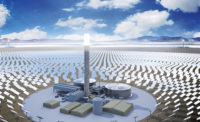Congested Power Plant Site Forces a Hunt for Space
















Turning an unused pipe chase into an access tunnel for crews so they can walk safely under a busy street from the parking lot to the site epitomizes the type of workarounds that have kept the 70%-complete 500-MW replacement of the 460-MW Unit 3 Scattergood Generating Station on track. In addition, space was at a premium at the congested 41-acre site in Playa Del Rey. That set off a hunt for ways to fit in all the components of the $950-million job.
"Our most precious commodity on this project is every square foot of space," says Mike Rinehart, general superintendent for Kiewit Corp., the powerplant's engineer-procure-construct (EPC) contractor. "And one of the biggest challenges was getting everything to fit."
There were other site challenges. "The massive sloped hillside that compromised the site prior to project execution required Kiewit to design and build massive retaining walls while excavating and filling areas of the site to yield flat land," says Andrew Gardner, Kiewit's engineering project sponsor. "From an engineering perspective, this posed an incredible challenge due to the geotechnical conditions of the site, the highly active seismic zone as well as the facility's 'importance factor.'"
The project, begun two years ago, will replace Scattergood's 1970s-era Unit 3 power generator with a highly efficient combined-cycle natural-gas-and-steam turbine and two simple-cycle turbines. The equipment is supplied by General Electric under a $260-million contract.
Together, the new turbines will join the plant's existing two units to generate up to 830 MW of electrical power for the owner, the Los Angeles Dept. of Water and Power (LADWP). The turbines have fast start and ramp-up capabilities for short-term increases in electrical demand and for more flexible integration of renewable energy.
LADWP says the new turbines will be 33% more fuel efficient than the existing Unit 3. The project will also replace Unit 3's ocean cooling system with an air-cooled condenser for the combined-cycle unit and an air-cooled heat exchanger for the simple-cycle units.
Mobilizing the Troops
Before Kiewit crews—working under a $441-million contract—could begin erecting equipment and enclosures to house project components, the project leaders had to find lay-down space on a congested site while keeping the essential plant operating to provide power to the Los Angeles area.
To solve the riddle of getting up to 700 workers from the parking lot to the site, Kiewit turned to a 100-ft-long underground chase for oil pipes and other utilities that was used when the plant, which then burned oil, opened in the late 1950s. Kiewit discovered the 10-ft-dia concrete tunnel on powerplant drawings. Crews soon removed leftover piping and converted the chase into a pedestrian walkway for crews to go under Grand Avenue, which cuts across the Scattergood facility.
Because of a scarcity of space, Kiewit designed, installed and commissioned a temporary wastewater system in an unused corner of the facility that would not be disturbed by new construction, allowing LADWP's old wastewater system to be demolished.
This made room for the powerplant and the new wastewater facility that could handle both the existing powerplant and the new one under construction while not interrupting plant operations.












